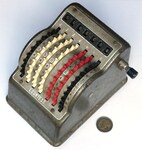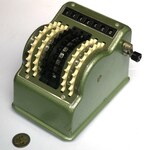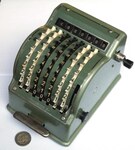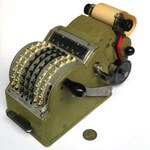



Countess (£sd)
Video
Countess (decimal)
Summira 7
Video
Summira S
Video
History
Articles and Advertisements
Links
The Countess is a small rotary adding machine. It has a 7-digit register, which in this case is adapted for adding British currency. The last number wheel counts from 0 to 11 and represents pence. The next two columns represent shillings, so count from 00 to 19. The other four number wheels are normal decimal wheels to represent the number of pounds.
There are 7 vertical slots on the front containing large toothed wheels. These wheels can be turned by using your fingers. You can insert your finger next to the digit you want to enter, and pull it all the way down to the bottom of the slot. This action immediately adds that amount to the main register at the top. The small crank on the right hand side clears the register.
On the back is a plaque stating "A Reliable Bowler Product", as Bowler Products Limited was the distributor for this machine in Britain.
The carry mechanism is quite simple. Each number wheel has a single tooth that engages the input wheel to its left, and when the number wheel turns past 9 the tooth moves the next input wheel to increment the next digit of the register. These teeth are spring-loaded and shaped so they retract when the input wheel they engage with is moved by the user. The carry from the shillings to the pounds column is adapted because it carries 5 times during a full rotation. It has a five-toothed wheel, and instead of retracting each tooth the whole wheel gets deflected sideways.
The machine has no serial number.
This is a decimal version of the Countess. Note that it does not have the name Countess on it, but it has the Bowler Products label on the back so I assume it was sold in Britain using the same name as the version for British currency. See the Countess above for more details. I don't know why there is an S to the right of the 1 of the units wheel.
The machine has no serial number.
The Summira 7 is a small rotary adding machine with direct subtraction, which is almost identical to the Resulta. It has a 7-digit register.
There are 7 vertical slots on the front containing what looks like large toothed wheels, with the digits 0 to 9 marked on the teeth. You can place your finger on the digit you want to enter, and pull it all the way down to the bottom of the slot. It then stays there, so that after you have entered all the digits of the number, the entered number can be read off at the bottom. Entering a number like this also immediately adds that amount to the main register at the top. The input wheels are reset by pushing the paddle at the front of the machine so that the next number can be entered.
The small crank on the right hand side clears the register. You rotate it until it is stopped by hitting the pin on the side of the case. The black knob on that side can be turned so that it locks down the front paddle, allowing a digit to be added repeatedly in quick succession which is useful for small multiplications.
There is a switch lever on the right that changes between addition and subtraction mode. In subtraction mode the register shifts to connect to the input via intermediate gears, and that unfortunately means it is no longer visible in the windows. While subtracting, the clearing crank has a tendency to move backwards, but since the axle has moved with the register it clears the stopping pin and moves freely.
On the back is a metallic sticker with the serial number 67043.
The mechanism of the Countess is a simplified version of this mechanism. Underneath the toothed input sections are the complete wheels that the Countess uses, and the carry mechanism in the register is identical.
The Summira S is like the Summira 7 above but with a printing mechanism attached. It is somewhat similar to the version of the Lipsia Addi 7 with printing mechanism.
The adding machine part is almost identical to the normal Summira 7. The only differences are that the knob for latching down the input clearing paddle is on the left side away from the printing lever, and the register window is larger so that the numbers remain visible in subtraction mode.
The printing mechanism is very simple. The printing heads are connected to the input wheels, so that they always represent the current input value. When you pull the large printing lever, the paper roll is pulled forward and squashes the ink ribbon against the printing heads, printing the current input onto the paper. Then the printing lever is returned the ink ribbon is spooled along a smmall amount, and the paper is moved up by one line. The axle for the ink ribbon spools can be shifted left or right, changing which of the spools connects to the mechanism, thereby changing the ribbon direction. The ink ribbon has two colours, and when you change to subtraction mode the ribbon is moved upwards so that it will print in red.
On the back is a metallic sticker with the serial number 36126.
The input wheels are connected to the printer heads through chains.
Summira GmbH was a company founded by Paul G. Müller and his sons Peter and Eberhard, in the village of Roisdorf which lies just outside Bonn. It is unclear which year the company was founded, because their website says 1957 while the earliest Summira adders were on the market in 1954. Apparently the adding machines were designed by Fritz Wiechert, who had previously worked on the Resulta for Paul Brüning in Berlin.
Summira made small adding machines of several models. There were two main types. Firstly there were various Summira models which could not only add but also do direct subtraction. Mechanically these were almost identical to the Resulta machines. Secondly there were simplified cheaper versions which could only do addition, and these versions had various names other than Summira.
| Name | # digits | Year | Remarks |
|---|---|---|---|
| Summira 7 | 7 | 1954 | Direct subtraction |
| Summira S or S7 | 7 | 1956 | Direct subtraction, printing |
| Summira 9 | 9 | 1959? | Direct subtraction |
| Countess | 7 | 1960 | Addition only. Usually for British Currency |
| Hoffritz / Chieftain | 7 | 1960? | Subtraction by complementary digits |
It is not clear when production of these adding machines ended, but I suspect that it did not last long into the 1960s. By the end of the 1970s the company had switched to manufacturing small custom products, having invested in a CNC lathe. The company still exists to this day, and specialises in CAD design, various CNC production techniques, and prototyping.
I have not found any ads for the Countess, only for the Summira.
© Copyright 2022 Jaap Scherphuis, mechcalc a t jaapsch d o t net.